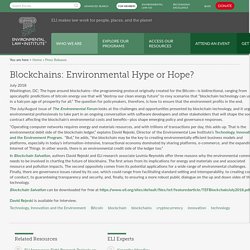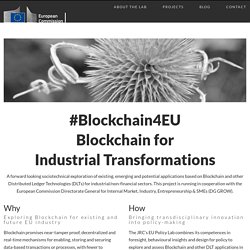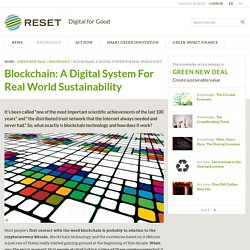

All this information can be viewed by any user, but can not be changed later. The DLT includes various methods such as IOTA, Hashgraph or Blockchain, the most well-known DL technology. Blockchain technology has also already had its first environmental effects, for example with regard to the high energy consumption. The trade in bit coins therefore consumes more energy than Hong Kong (44 TWh / year). The more frequently transactions with cryptocurrencies are carried out, the more energy is required.
Implications: A systematic discourse on negative environmental effects and opportunities for the environment has not yet been established, even if there are considerations and pilot projects, such as "Ecocoins" as an alternative currency to Bitcoins, whose payment is linked to sustainability criteria or in relation on the potential of blockchain technology for the sha-ring economy. Blockchain is a fully transparent peer-to-peer technology that allows multiple types of transactions (payment, contracts, etc.) to take place directly between different subscribers. The transparency of supply chains could also be massively increased, for example, by requiring all intermediate stations of a product to be verified in a blockchain and, subsequently, not being able to be changed any further.
Relations to EEA Global Megatrends:
Scanners: Miklós & Sylvie
First entry: 14/06/18
Last update: 14/06/18.
The Hidden Cost of Bitcoin? Our Environment. 11 Blockchain Startups Transforming the Environment - EtonDigital. The blockchain and the environment, what’s the connection? How decentralised and peer-to-peer ecological systems can empower social activism? Eco-friendly blockchain startups can be used to solve the major environmental problems we face today. Transparency and veracity across the digital information ecosystem are some of the reasons. How to Limit Bitcoin's Energy Consumption Problem.
It's hard to imagine a digital currency being bad for the environment but the process to mine a single bitcoin consumes a considerable amount of energy.

A new paper, however, suggests there is a way to mitigate bitcoin's energy problem through regulation. Bitcoin mining is the process of adding bitcoin transactions to a public ledger, called the blockchain. To do this, miners use powerful computing chips and mining machines that help mining software unveil bitcoins. “Each [mining machine] uses an enormous amount of power. Decoding the environmental impacts of cryptocurrencies and the potential solutions - The Solutions Journal. In Brief The rise of cryptocurrency and the blockchain technology that underpins it has a potentially transformative effect on international commerce.

Despite the vast potential of the technology, there are problems. Bitcoin, the first modern cryptocurrency, relies on vast amounts of computational power (and therefore, electricity) to operate – bitcoin consumes as much electricity as some countries. An estimated 85% of cryptocurrency mining occurs in China, where electricity is cheap and largely sourced from environmentally unsustainable sources like coal-powered plants. Realizing blockchain's potential for social impact. As is usually the case with disruptive new technology, blockchain comes with a lot of hype. While its best-known application, bitcoin, divides opinion and makes banks and governments nervous, the technology may have great potential to advance social good. Serving the underserved Fintech companies across the globe are using blockchain to improve financial systems and redefine how businesses and individuals make payments. Blockchains: Environmental Hype or Hope?
Washington, DC: The hype around blockchains—the programming protocol originally created for the Bitcoin—is bidirectional, ranging from apocalyptic predictions of bitcoin energy use that will “destroy our clean energy future” to rosy scenarios that “blockchain technology can usher in a halcyon age of prosperity for all.”

The question for policymakers, therefore, is how to ensure that the environment profits in the end. The July/August issue of The Environmental Forum looks at the challenges and opportunities presented by blockchain technology, and it urges environmental professionals to take part in an ongoing conversation with software developers and other stakeholders that will shape the social contract affecting the blockchain’s environmental costs and benefits—plus shape emerging policy and governance responses.
“Operating computer networks requires energy and materials resources, and with trillions of transactions per day, this adds up. Blockchain for a better planet. Sustainability 10 03652. Blockchain & Environment – Complexity Labs. 12439. The Environmental Impacts of Bitcoin – Wolverine Blockchain. Wait, how can digital currency affect the environment?

Bitcoin’s energy usage is huge – we can't afford to ignore it. Bitcoin’s electricity usage is enormous.

In November, the power consumed by the entire bitcoin network was estimated to be higher than that of the Republic of Ireland. Since then, its demands have only grown. It’s now on pace to use just over 42TWh of electricity in a year, placing it ahead of New Zealand and Hungary and just behind Peru, according to estimates from Digiconomist.
That’s commensurate with CO2 emissions of 20 megatonnes – or roughly 1m transatlantic flights. That fact should be a grave notion to anyone who hopes for the cryptocurrency to grow further in stature and enter widespread usage. 7 Ways Blockchain Can Save The Environment and Stop Climate Change. #Blockchain4EU: Blockchain for Industrial Transformations. A forward looking sociotechnical exploration of existing, emerging and potential applications based on Blockchain and other Distributed Ledger Technologies (DLTs) for industrial/non-financial sectors.

This project is running in cooperation with the European Commission Directorate General for Internal Market, Industry, Entrepreneurship & SMEs (DG GROW). Cryptocurrencies and blockchain - Think Tank. How blockchain technology could change our lives - Think Tank. An initiative of the European Commission. European Commission launches the EU Blockchain Observatory and Forum. What if blockchain were to be truly decentralised? [Scientific and Technology Podcast] Written by Mihalis Kritikos, © Beautyimage / Shutterstock.com Technological systems, once introduced in a particular socio-economic context, often evolve in unforeseen ways and may fall prey to unexpected power relations.
![What if blockchain were to be truly decentralised? [Scientific and Technology Podcast]](http://cdn.pearltrees.com/s/pic/th/blockchain-decentralised-186834086)
#Blockchain4EU: Blockchain for Industrial Transformations. Blockchain and other Distributed Ledger Technologies (DLTs) are immutable, encrypted and timestamped databases, in which data is recorded, validated and replicated across a decentralised network of nodes.

A range of opportunities and challenges could emerge through such technologies that will potentially enable parties who are geographically distant, or have no particular trust in each other, to record, verify and share digital or digitised assets on a peer-to-peer basis with fewer to no intermediaries. A Deeper Look at Cryptocurrencies - Bitcoin, Ethereum and Ripple - The Red. In 2017, Bitcoin, a digital currency launched in 2009, monopolized international finance headlines.

On 1st January 2017, a Bitcoin was worth 972 USD while one year later, on 1st January 2018, you would have needed to invest 14.000 USD to buy a single token, down from nearly 20.000 USD on 17 December 2017. Considering the same timeframe, its market capitalization rose from 15,5 billion to 233 billion US dollars, after having reached its peak on 17 December 2017 at 335 billion (Cryptocurrency Market Capitalizations).
Le bitcoin, gouffre énergétique et péril climatique. Untitled. Most people's first contact with the word blockchain is probably in relation to the cryptocurrency Bitcoin.

Blockchain technology and the currencies based on it (Bitcoin is just one of them) really started gaining ground at the beginning of this decade. When was the exact moment that people started taking notice of these cryptocurrencies? It was probably when someone using the pseudonym of Satoshi Nakamoto published a white paper in 2008, explaining for the first time what exactly Bitcoin is. 2008 was also the year when the collapse of the US investment bank Lehman Brothers caused a stock market crash and set off a global financial crisis that went on for years.
The-Future-is-Decentralised. Block chains, distributed ledgers & the future of sustainable development The potential of block chains to disrupt industrial sectors, commercial processes, governmental structures or economic systems seems to know no bounds. We suggest that the transformative power of block chain technology should not be seen as a threat to existing systems of governance; rather, it should be seen as an opportunity for national and international institutions to defend the rights of those they represent and to accelerate our collective progress towards meeting the United Nations’ Sustainable Development Goals. Blockchains for Sustainability. Crowd-based reporting mechanisms replace costly and corruptible auditors to ensure qualitative and quantitative Sustainable Fair Trade without delays. Fair Trade has been around for 70 years, linking consumers with an awareness for fair wages to producers willing to respond to their demands.
Today the concept of Fair Trade is increasingly linked to a broader social and environmental responsibility: Sustainable Fair Trade. The common pitfalls for Fair Trade are the cost of uncorrupted verification of standards and their chain of custody. With the rise of decentralized digital network technology, first implemented in 2009 as a core component of the crypto-currency Bitcoin, the barriers to Fair Trade have changed. Blockchain Top Trends In 2017. Kryptowährungen: Eine Grafikkarte nur zum Minen.